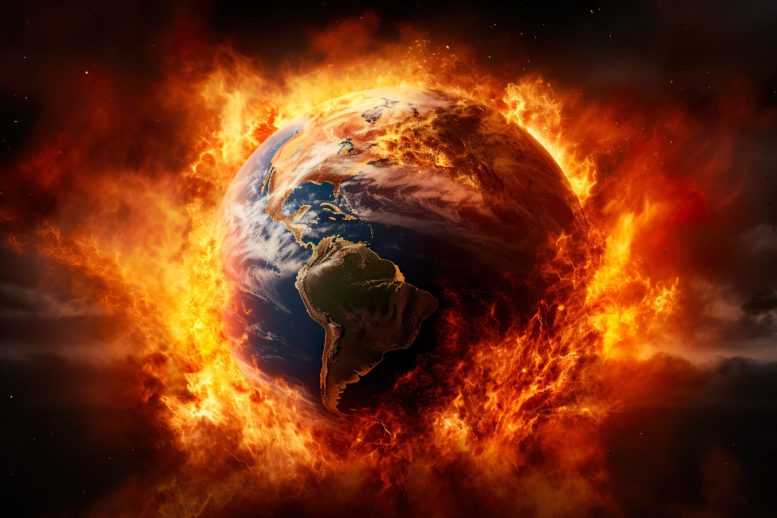
The second annual Indicators of Global Climate Change report shows a rise in human-induced warming to 1.19°C over the last decade and emphasizes the critical low remaining carbon budget of 200 gigatonnes, indicating just five years of current emissions levels. The report highlights the urgency of robust climate action to combat the ongoing increases in global warming and its impacts. Credit: SciTechDaily.com
Latest climate report indicates a concerning increase in human-induced warming and a rapidly diminishing carbon budget, underscoring the urgent need for global climate action.
The second annual Indicators of Global Climate Change report, reveals that human-induced warming has risen to 1.19 °C over the past decade (2014-2023) – an increase from the 1.14 °C seen in 2013-2022 (set out in last year’s report). The research was led by the University of Leeds.
Looking at 2023 in isolation, warming caused by human activity reached 1.3 °C. This is lower than the total amount of warming we experienced in 2023 (1.43 °C), indicating that natural climate variability, in particular El Niño, also played a role in 2023’s record temperatures.
Carbon Budget Constraints
The analysis also shows that the remaining carbon budget — how much carbon dioxide can be emitted before committing us to 1.5 °C of global warming — is only around 200 gigatonnes (billion tonnes). This is only five years’ worth of current emissions.
In 2020, the Intergovernmental Panel on Climate Change (IPCC) calculated the remaining carbon budget for 1.5 °C was in the 300 to 900 gigatonnes of carbon dioxide range, with a central estimate of 500. Since then, CO2 emissions and global warming have continued. At the start of 2024, the remaining carbon budget for 1.5 °C stood at 100 to 450 gigatonnes, with a central estimate of 200.
Expert Analysis and Climate Predictions
The Indicators of Global Climate Change Project is being coordinated by Professor Piers Forster, Director of the Priestley Centre for Climate Futures at the University of Leeds. He said: “Our analysis shows that the level of global warming caused by human action has continued to increase over the past year, even though climate action has slowed the rise in greenhouse gas emissions. Global temperatures are still heading in the wrong direction and faster than ever before.
“Our analysis is designed to track the long-term trends caused by human activities. Observed temperatures are a product of this long-term trend modulated by shorter-term natural variations. Last year, when observed temperature records were broken, these natural factors were temporarily adding around 10% to the long-term warming.”
Preparation for COP29 and the Importance of Updated Climate Data
The warning comes as climate experts meet in Bonn to prepare the ground for the COP29 climate conference which takes place in November in Baku, Azerbaijan.
The authoritative source of scientific information on the state of the climate is the UN’s Intergovernmental Panel on Climate Change (IPCC), but as its next major assessment will not happen until around 2027, this creates an “information gap”, particularly when climate indicators are changing rapidly.
The new report is accompanied by an open data, open science platform – the Climate Change Tracker’s Indicators of Global Climate Change dashboard which provides easy access to updated information on the key climate indicators.
Insights From Reduced Sulfur Emissions
The latest Indicator report, which is published by more than 50 scientists in the journal Earth System Science Data, also provides new insight into the effects of reductions in sulfur emissions from the global shipping industry. The sulfur has a cooling effect on the climate by directly reflecting sunlight back to space and by helping more reflective clouds to form, but ongoing reductions in those emissions have lessened that effect.
Although this was offset last year by the aerosol emissions from the Canadian wildfires, the report says the longer-term trend nonetheless indicates that the amount of cooling we can expect from aerosol emissions is continuing to decline.
Other Key Findings:
- Human-induced warming has risen to 1.19 °C over the past decade (2014-2023) – an increase from the 1.14 °C seen in 2013-2022 (set out in last year’s report).
- Human-induced warming has been increasing at a rate that is unprecedented in the instrumental record, reaching roughly 0.26 °C per decade over 2014-2023.
- This high rate of warming is caused by a combination of greenhouse gas emissions being consistently high, equivalent to 53 billion tonnes of CO2 per year, as well as ongoing improvements in air quality, which are reducing the strength of human-caused cooling from particles in the atmosphere.
- High GHG emission levels are also affecting the Earth’s energy balance: ocean buoys and satellites are tracking unprecedented flows of heat into the Earth’s oceans, ice caps, soils and atmosphere. This flow of heat is 50% higher than its long-term average.
Professor Forster added: “Fossil fuel emissions are around 70% of all GHG emissions and clearly the main driver of climate change, but other sources of pollution from cement production, farming and deforestation and cuts to the level of sulfur emissions are also contributing to warming.
“Rapidly reducing emissions of greenhouse gases towards net zero will limit the level of global warming we ultimately experience. At the same time, we need to build more resilient societies. The devastation wrought by wildfires, drought, flooding, and heat waves the world saw in 2023 must not become the new normal.”
Implications for Future Climate Policies
It is hoped that the report will play a strong role in informing new Nationally Determined Contributions, the improved climate plans that every country in the world has promised to put forward to the United Nations Framework Convention on Climate Change (UNFCCC) by 2025 to cut emissions and adapt to climate impacts.
Reference: “Indicators of Global Climate Change 2023: annual update of large-scale indicators of the state of the climate system and human influence” by Piers M. Forster, Chris Smith, Tristram Walsh, William F. Lamb, Robin Lamboll, Bradley Hall, Mathias Hauser, Aurélien Ribes, Debbie Rosen, Nathan P. Gillett, Matthew D. Palmer, Joeri Rogelj, Karina von Schuckmann, Blair Trewin, Myles Allen, Robbie Andrew, Richard A. Betts, Alex Borger, Tim Boyer, Jiddu A. Broersma, Carlo Buontempo, Samantha Burgess, Chiara Cagnazzo, Lijing Cheng, Pierre Friedlingstein, Andrew Gettelman, Johannes Gütschow, Masayoshi Ishii, Stuart Jenkins, Xin Lan, Colin Morice, Jens Mühle, Christopher Kadow, John Kennedy, Rachel E. Killick, Paul B. Krummel, Jan C. Minx, Gunnar Myhre, Vaishali Naik, Glen P. Peters, Anna Pirani, Julia Pongratz, Carl-Friedrich Schleussner, Sonia I. Seneviratne, Sophie Szopa, Peter Thorne, Mahesh V. M. Kovilakam, Elisa Majamäki, Jukka-Pekka Jalkanen, Margreet van Marle, Rachel M. Hoesly, Robert Rohde, Dominik Schumacher, Guido van der Werf, Russell Vose, Kirsten Zickfeld, Xuebin Zhang, Valérie Masson-Delmotte, and Panmao Zhai, 5 June 2024, Earth System Science Data.
DOI: 10.5194/essd-16-2625-2024, 2024









“The sulfur has a cooling effect on the climate by directly reflecting sunlight back to space and by helping more reflective clouds to form, but ongoing reductions in those emissions have lessened that effect.
Although this was offset last year by the aerosol emissions from the Canadian wildfires, …”
This reads as though there was negligible CO2 released by the Canadian wildfires.
If the past forecasts were anywhere near being close to what actually happened, then there might be cause for alarm. However, the past forecast record is so dismal that one would stand a better chance of being right by betting AGAINST the forecasts.
Another limp-wristed scare story, given the lie to, ironically, with a new NASA report which, along with recent revelations demonstrating the cruccial role of solar activity as a major climate influenc, shows how little we really know about this incredibly complex branch of science. And yet we continue to use the same old, phony, patently-manufactured “consensus” to carrying out irresponsible (but profitable!) geo-engineering projects and to justify “green” policies which are having little if any influence our climate while undermining nconomies across the West and degrading and destroying countless millions of lives. But isn’t this the primary objective of this tedious exercise, anyway?
https://dailysceptic.org/2024/06/04/almost-all-recent-global-warming-caused-by-green-air-policies-shock-revelation-from-nasa/
With respect to taking action it’s worth noting that if we were to lower CO2 emissions toward zero by 2050 that would have no effect on the climate because that would take none of the CO2 already added out of the atmosphere to lower global temperatures.